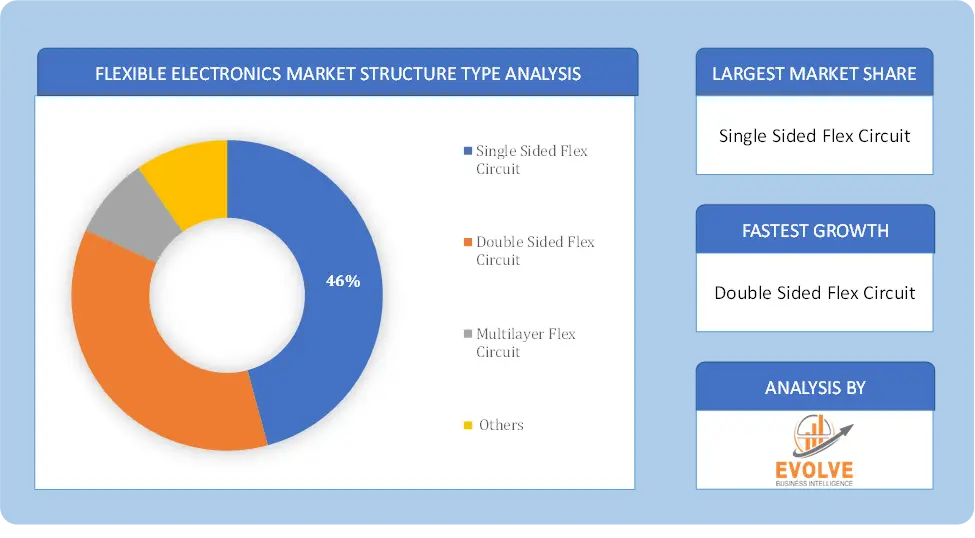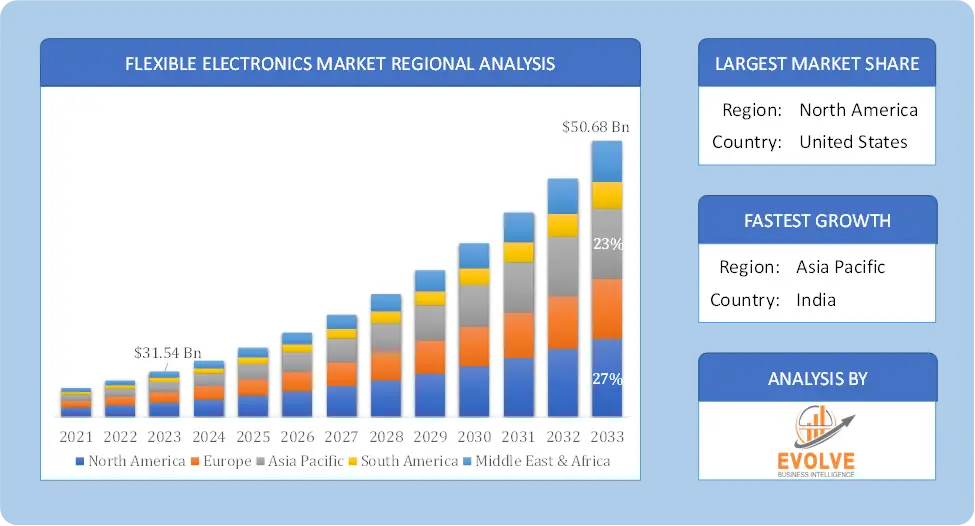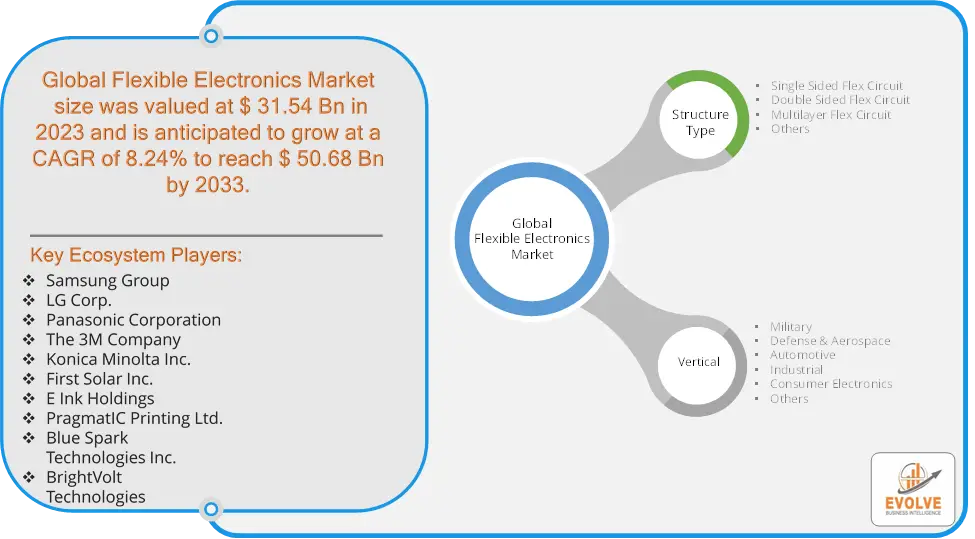Price range: $ 1,390.00 through $ 5,520.00
Flexible Electronics Market Research Report: Information By Structure Type (Single Sided Flex Circuit, Double Sided Flex Circuit, Multilayer Flex Circuit, Others), By Vertical (Military, Defense & Aerospace, Automotive, Industrial, Consumer Electronics, Others), and by Region — Forecast till 2033
Page: 159
Description
Flexible Electronics Market Overview
The Flexible Electronics Market Size is expected to reach USD 50.68 Billion by 2033. The Flexible Electronics Market industry size accounted for USD 31.54 Billion in 2023 and is expected to expand at a compound annual growth rate (CAGR) of 8.24% from 2023 to 2033. The Flexible Electronics Market refers to the industry involved in the production and commercialization of electronic devices and components that are flexible and can be bent, folded, or stretched. This market includes various types of flexible electronic products such as flexible displays, flexible sensors, flexible batteries, and flexible printed circuits.
The Flexible Electronics Market is a rapidly evolving sector with significant potential for innovation and growth due to its applications in various high-tech and consumer products.
Global Flexible Electronics Market Synopsis
The COVID-19 pandemic significant impacts on the Flexible Electronics Market. The pandemic led to significant disruptions in global supply chains, affecting the availability of raw materials and components necessary for manufacturing flexible electronics. Lockdowns and restrictions impacted production facilities and logistics. With increased reliance on remote work and online activities during the pandemic, there was a heightened demand for consumer electronics, including flexible displays and wearables. This shift drove interest in flexible electronics, particularly in sectors like health monitoring and remote communication. The focus on health and safety during the pandemic accelerated the adoption of wearable health devices, such as flexible sensors for monitoring vital signs. This trend contributed to growth in the flexible electronics sector. The economic downturn caused by the pandemic led to reduced consumer spending and investment in some areas, which might have temporarily slowed growth in the flexible electronics market. However, the overall impact was mitigated by the increased demand for certain electronic products.
Flexible Electronics Market Dynamics
The major factors that have impacted the growth of Flexible Electronics Market are as follows:
Drivers:
Ø Technological Advancements
Innovations in materials and manufacturing processes, such as flexible substrates, organic semiconductors, and roll-to-roll printing technologies, are enhancing the performance and cost-effectiveness of flexible electronics. The adoption of flexible displays in smartphones, tablets, and other consumer devices is expanding. Flexible electronics offer benefits like improved durability, lighter weight, and the ability to create innovative form factors. Flexible electronics are increasingly used in health monitoring devices, such as wearable health trackers and smart textiles, which are in high demand due to a growing focus on personal health and wellness.
Restraint:
- Perception of High Manufacturing Costs and Technological Challenges
The production of flexible electronics often involves expensive materials and complex manufacturing processes, which can lead to higher costs compared to traditional rigid electronics. This can limit their adoption, especially in cost-sensitive applications. Achieving high performance and efficiency in flexible electronics can be challenging. Issues related to the integration of flexible components with other electronic systems, as well as maintaining consistent performance over time, can pose significant hurdles.
Opportunity:
⮚ Development of Smart Textiles
The integration of flexible electronics into textiles can lead to the creation of smart clothing and fabrics with applications in health monitoring, sports performance enhancement, and interactive fashion. This emerging sector holds significant growth potential. Flexible displays and touchscreens are increasingly being used in consumer electronics like smartphones, tablets, and televisions. The ability to create more versatile and innovative form factors can drive new product development and market growth. The increasing adoption of IoT devices presents opportunities for flexible electronics, particularly in creating flexible sensors and communication devices that can be seamlessly integrated into smart systems and infrastructure.
Flexible Electronics Market Segment Overview
By Structure Type
 Based on Structure Type, the market is segmented based on Single Sided Flex Circuit, Double Sided Flex Circuit, Multilayer Flex Circuit and Others. The Double Sided Flex Circuit segment dominant the market.
Based on Structure Type, the market is segmented based on Single Sided Flex Circuit, Double Sided Flex Circuit, Multilayer Flex Circuit and Others. The Double Sided Flex Circuit segment dominant the market.
By Vertical
Based on Vertical, the market segment has been divided into Military, Defense & Aerospace, Automotive, Industrial, Consumer Electronics and Others. The consumer electronics segment dominant the market. This is simply attributed to the rapid advancements in the consumer electronics and development of designer products that attracts the consumers and hence boosts the sales of the latest electronic products. The rising demand for the consumer electronics across the globe is the primary driver of the consumer electronics segment.
Global Flexible Electronics Market Regional Analysis
Based on region, the global Flexible Electronics Market has been divided into North America, Europe, Asia-Pacific, the Middle East & Africa, and Latin America. North America is projected to dominate the use of the Flexible Electronics Market followed by the Asia-Pacific and Europe regions.
 Flexible Electronics North America Market
Flexible Electronics North America Market
North America holds a dominant position in the Flexible Electronics Market. The U.S. and Canada are leading the market due to high technological adoption, significant investments in research and development, and a strong presence of key players. There is opportunity in Innovation in smart textiles, advancements in health monitoring devices, and the development of flexible displays.
Flexible Electronics Asia-Pacific Market
The Asia-Pacific region has indeed emerged as the fastest-growing market for the Flexible Electronics Market industry. This region is experiencing rapid growth due to a booming consumer electronics industry, technological advancements, and a large manufacturing base. China, Japan, South Korea, and India are prominent contributors and there is expansion in wearable technology, growth in the automotive sector, and increasing investments in research and development.
Competitive Landscape
The global Flexible Electronics Market is highly competitive, with numerous players offering a wide range of software solutions. The competitive landscape is characterized by the presence of established companies, as well as emerging startups and niche players. To increase their market position and attract a wide consumer base, the businesses are employing various strategies, such as product launches, and strategic alliances.
Prominent Players:
- Samsung Group
- LG Corp.
- Panasonic Corporation
- The 3M Company
- Konica Minolta Inc.
- First Solar Inc.
- E Ink Holdings
- PragmatIC Printing Ltd.
- Blue Spark Technologies Inc.
- BrightVolt Technologies
Scope of the Report
Global Flexible Electronics Market, by Structure Type
- Single Sided Flex Circuit
- Double Sided Flex Circuit
- Multilayer Flex Circuit
- Others
Global Flexible Electronics Market, by Vertical
- Military
- Defense & Aerospace
- Automotive
- Industrial
- Consumer Electronics
- Others
Global Flexible Electronics Market, by Region
- North America
- US
- Canada
- Mexico
- Europe
- UK
- Germany
- France
- Italy
- Spain
- Benelux
- Nordic
- Rest of Europe
- Asia Pacific
- China
- Japan
- South Korea
- Indonesia
- Austalia
- Malaysia
- India
- Rest of Asia Pacific
- South America
- Brazil
- Argentina
- Rest of South America
- Middle East & Africa
- Saudi Arabia
- UAE
- Egypt
- South Africa
- Rest of Middle East & Africa
| Parameters | Indicators |
|---|---|
| Market Size | 2033: $50.68 Billion |
| CAGR | 8.24% CAGR (2023-2033) |
| Base year | 2022 |
| Forecast Period | 2023-2033 |
| Historical Data | 2021 |
| Report Coverage | Revenue Forecast, Competitive Landscape, Growth Factors, and Trends |
| Key Segmentations | Structure Type, Vertical |
| Geographies Covered | North America, Europe, Asia-Pacific, Latin America, Middle East, Africa |
| Key Vendors | Samsung Group, LG Corp., Panasonic Corporation, The 3M Company, Konica Minolta Inc., First Solar Inc., E Ink Holdings, PragmatIC Printing Ltd., Blue Spark Technologies Inc. and BrightVolt Technologies |
| Key Market Opportunities | • Development of Smart Textiles • Integration with Internet of Things (IoT) |
| Key Market Drivers | • Technological Advancements • Increasing Use in Consumer Electronics |
REPORT CONTENT BRIEF:
- High-level analysis of the current and future Flexible Electronics Market trends and opportunities
- Detailed analysis of current market drivers, restraining factors, and opportunities in the future
- Flexible Electronics Market historical market size for the year 2021, and forecast from 2023 to 2033
- Flexible Electronics Market share analysis at each product level
- Competitor analysis with detailed insight into its product segment, Government & Defense strength, and strategies adopted.
- Identifies key strategies adopted including product launches and developments, mergers and acquisitions, joint ventures, collaborations, and partnerships as well as funding taken and investment done, among others.
- To identify and understand the various factors involved in the global Flexible Electronics Market affected by the pandemic
- To provide a detailed insight into the major companies operating in the market. The profiling will include the Government & Defense health of the company’s past 2-3 years with segmental and regional revenue breakup, product offering, recent developments, SWOT analysis, and key strategies.
Frequently Asked Questions (FAQ)
What is the growth rate of the global Flexible Electronics Market?
The global Flexible Electronics Market is growing at a CAGR of 8.24% over the next 10 years
Which region has the highest growth rate in the market of Flexible Electronics Market?
Asia Pacific is expected to register the highest CAGR during 2023-2033
Which region has the largest share of the global Flexible Electronics Market?
North America holds the largest share in 2022
Who are the key players in the global Flexible Electronics Market?
Samsung Group, LG Corp., Panasonic Corporation, The 3M Company, Konica Minolta Inc., First Solar Inc., E Ink Holdings, PragmatIC Printing Ltd., Blue Spark Technologies Inc. and BrightVolt Technologies are the major companies operating in the market
Do you offer Post Sale Support?
Yes, we offer 16 hours of analyst support to solve the queries
Do you sell particular sections of a report?
Yes, we provide regional as well as country-level reports. Other than this we also provide a sectional report. Please get in contact with our sales representatives
Additional information
| Packages | Single User License, Enterprise License, Data Pack Excel |
|---|
Table of Content
[html_block id="8068"]


